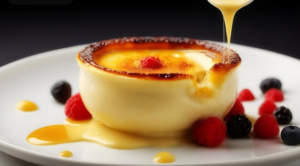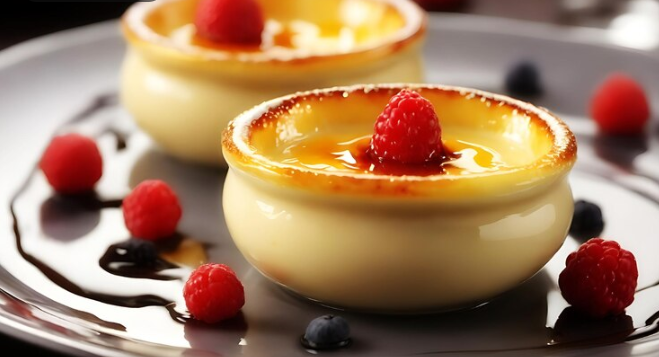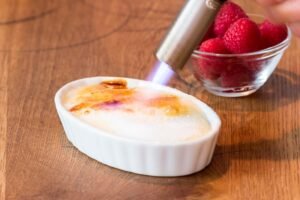Discovering the Difference Between Panna Cotta and Crème Brûlée
Is panna cotta the same as crème brûlée? Panna Cotta and Crème Brûlée are two classic desserts enjoyed worldwide, each with its unique flavor and cultural background.
Panna Cotta, or « cooked cream » in Italian, embodies the simplicity of Italian cuisine with ingredients like cream, sugar, and gelatin. It’s known for its silky texture and gentle wobble. Originally from Northern Italy, Panna Cotta has transformed from a local farmer’s treat into a globally recognized dessert.
Crème Brûlée, a luxurious French dessert, combines creamy custard with a caramelized sugar crust. Its origins are debated but trace back to early 17th-century France. Crème Brûlée is celebrated for its rich texture and the dramatic contrast between the brittle caramel top and the creamy base.
The comparison of Panna Cotta and Crème Brûlée goes beyond recipes and flavors. It explores how these desserts mirror their cultural heritages and culinary traditions. This comparison not only highlights the diversity of desserts but also emphasizes food as an element of cultural expression. Through understanding these desserts, we delve into the artistry of dessert making and its universal appeal.
Defining Panna Cotta
Panna Cotta is an Italian dessert meaning « cooked cream. » Made from heavy cream, sugar, and gelatin, it sets into a silky texture. Ingredients are heated, mixed with gelatin, and cooled in molds. Originating from Italy’s Piedmont region, its exact history is unclear but it is cherished globally for its simplicity and elegance.
Variations of Panna Cotta
Panna Cotta adapts to many flavors like vanilla, espresso, and matcha. It’s often enhanced with fruit purées, chocolate, or spices such as cinnamon. In Italy, it’s typically served with berries or caramel, while internationally, it may feature local fruits or unique toppings, reflecting regional tastes.
Defining Crème Brûlée
Crème Brûlée, French for « burnt cream, » features a rich custard base topped with a contrasting layer of hard caramel. It is typically made from ingredients such as heavy cream, egg yolks, sugar, and vanilla. The custard is mixed from heated cream and vanilla, combined with beaten egg yolks and sugar, then poured into ramekins. It is cooked in a water bath until just set but still jiggly in the center. The signature caramelized top is achieved by sprinkling sugar over the custard and torching it until it melts and hardens into a crispy layer.
The dessert’s history is debated, with claims of its origin from France, England, and Spain as early as the 17th century. Despite its disputed beginnings, it has become a hallmark of French cuisine, often representing the epitome of fine dining desserts.
Variations of Crème Brûlée
Crème Brûlée’s basic recipe welcomes various interpretations and flavors. Innovations include infusions like lavender, chai, or citrus to enhance the custard. Chefs have also experimented with the sugar topping, using demerara or muscovado for deeper flavor profiles. Regionally, variations in the custard’s thickness and the type of sugar used for caramelizing reflect local preferences and culinary traditions, demonstrating the dessert’s versatility in adapting to different tastes and techniques.

Ingredients and Texture Comparison
Panna Cotta and Crème Brûlée may both be creamy desserts, but their ingredients and textures reveal significant differences. Panna Cotta is primarily made from cream, sugar, and gelatin—the gelatin acting as a setting agent, giving it a delicate, wobbly texture that is smooth and silky. It does not contain eggs, which distinguishes its lighter consistency from many other custard-based desserts.
Crème Brûlée, in contrast, includes heavy cream and sugar but is thickened with egg yolks instead of gelatin. The egg yolks not only contribute to a richer flavor but also provide a denser, custard-like texture that is firm enough to support a layer of hard caramelized sugar on top, The texture of Crème Brûlée is smoother and more substantial compared to the jiggly softness of Panna Cotta.
The caramelized sugar topping of Crème Brûlée also adds a unique textural element not found in Panna Cotta. When tapped with a spoon, the burnt sugar cracks, revealing the creamy custard underneath, which contrasts sharply with the uniformly soft texture of Panna Cotta.
Flavor and Serving
When it comes to flavor, Panna Cotta and Crème Brûlée offer distinct experiences. Panna Cotta typically has a mild, milky flavor with hints of vanilla or other added essences, which serve as the primary flavor profiles. It’s often served with sauces or fruits which complement its subtle taste.
Crème Brûlée‘s flavor is more pronounced, dominated by the rich, creamy taste of custard and the caramelized depth from the burnt sugar topping. The caramelization process intensifies the dessert’s flavor, making it a bolder choice compared to the gentle notes of Panna Cotta.
Both desserts are typically served chilled or at room temperature. Panna Cotta is often unmolded onto a plate, sometimes garnished with fruit or drizzles of sauce. Crème Brûlée is usually served in its ramekin, a presentation that keeps the caramel topping perfectly intact until it’s cracked open just before eating. This difference in serving styles highlights their textural contrasts and how these contribute to the overall dining experience.
Health and Dietary Aspects
When comparing the nutritional content of Panna Cotta and Crème Brûlée, it’s important to note both desserts are rich in calories due to their high cream and sugar content. Panna Cotta, typically lighter, contains approximately 300 calories per serving, depending on additional ingredients like fruits or flavorings. Its primary ingredients (cream, sugar, and gelatin) contribute mainly to its calorie count but offer limited nutritional benefits.
Crème Brûlée is calorie-denser, often reaching up to 500 calories per serving, mainly from the heavy cream and large quantity of egg yolks, which add both calories and fats but also provide protein. The caramelized sugar topping, while delicious, increases the simple carbohydrate content, which can impact blood sugar levels.
For those seeking gluten-free options, both desserts naturally do not contain gluten, but it’s always important to check cross-contamination in commercial preparations. Vegan variations are possible for both desserts. Vegan Panna Cotta can be made using plant-based milks and agar-agar instead of gelatin. this Crème Brûlée can be prepared with ingredients like coconut cream, silken tofu, or cashew cream as bases, and turbinado sugar for caramelization, offering a similar texture and flavor profile to their traditional counterparts. These adaptations make it possible for individuals following specific diets to enjoy these delightful desserts.
Mastering Dessert Preparation
Achieving the perfect texture and flavor in desserts like Panna Cotta and Crème Brûlée is as much an art as it is a science. Here are some step-by-step guidelines and tips to help you master these elegant desserts.
Panna Cotta: Perfecting Silky Smoothness
- Heat Gently: Begin by gently heating the cream and sugar mixture, ensuring it doesn’t boil. Boiling can cause the cream to separate.
- Dissolve Gelatin Properly: Ensure the gelatin is fully dissolved in the warm mixture. For a smooth texture, avoid adding gelatin directly into boiling cream as it can become stringy.
- Cool Before Setting: Allow the mixture to cool slightly before pouring it into molds. This prevents any air bubbles that might form during the setting process.
Crème Brûlée: Achieving a Custard Consistency
- Temper the Eggs: To avoid lumps in your custard, gradually temper the beaten eggs with the hot cream mixture. This means adding a small amount of the hot liquid to the eggs first to raise their temperature without cooking them.
- Strain the Mixture: Strain the custard mixture through a fine sieve into the ramekins to remove any cooked egg bits and ensure a smooth texture.
- Bake in a Water Bath: Cook your Crème Brûlée in a water bath to maintain a gentle and even heat around the custard, preventing it from curdling.
Selecting Ingredients
- Quality Cream: For both desserts, using high-quality cream with a higher fat content can greatly enhance the flavor and texture.
- Fresh Vanilla: Opt for fresh vanilla beans or high-quality extract for the best flavor. The freshness of the vanilla makes a significant difference, especially in such simple desserts.
- Proper Gelatin and Eggs: Ensure your gelatin is fresh and your eggs are high-quality for optimum setting and texture.
By following these tips and paying attention to the details, you can create Panna Cotta and Crème Brûlée that are not only delicious but also visually stunning and texturally perfect.
Desserts Without Borders
The global journey of Panna Cotta and Crème Brûlée showcases their versatility and universal appeal, adapting to various culinary traditions and inspiring innovative dessert fusions.
Cultural Adaptations
Panna Cotta has traveled beyond Italy, adopting local flavors and ingredients. In Japan, matcha (green tea) Panna Cotta is a popular variation that combines the creamy texture of the dessert with the bitter notes of matcha. In tropical countries, coconut milk is often used instead of cream, infusing the dessert with a refreshing, light taste that suits the climate.
Similarly, Crème Brûlée has been embraced and modified in various regions. In Spain, a similar dessert known as ‘Crema Catalana’ is flavored with citrus zest and cinnamon, reflecting local tastes. In the United States, pumpkin spice Crème Brûlée becomes a seasonal favorite, incorporating the warm, comforting spices associated with autumn.
Fusion Desserts
Chefs worldwide experiment by blending elements of both desserts, creating unique culinary experiences. For example, some have introduced a Panna Cotta with a caramelized sugar top, combining the smooth texture of Panna Cotta with the satisfying crunch of Crème Brûlée’s caramelized topping. Others have crafted a Crème Brûlée flavored with traditional Panna Cotta elements like fresh berries or vanilla bean.
Culinary Competitions and Menus
Both desserts frequently feature in global culinary competitions, challenging chefs to elevate these classics in creativity and technique. In high-end dining, variations of Panna Cotta and Crème Brûlée often appear on menus, sometimes combined or presented in novel forms like deconstructed versions or as components of larger dessert compositions.
These desserts have proven their adaptability and enduring popularity, crossing cultural boundaries and continually evolving, which not only preserves their legacy but also ensures their future as staples in the global culinary landscape.
Cultural Impact
Panna Cotta and Crème Brûlée are key desserts in Italian and French cuisines, respectively. They are celebrated globally, showing their cultural significance and broad appeal.
Panna Cotta exemplifies Italian culinary simplicity. It uses minimal, high-quality ingredients to create a delightful dessert. It’s a regular in Italian eateries and often appears in culinary media, symbolizing Italian dessert art. Its adaptability allows for global variations, incorporating local flavors which show its universal appeal.
Crème Brûlée represents French elegance in dessert form. It’s common in French bistros and luxury dining worldwide. The dramatic moment when its caramelized sugar top is cracked is iconic in movies, books, and TV, often depicting luxury or romance. This has cemented its status as a sophisticated dessert.
Both desserts not only highlight their national origins—Italian and French—but also cross cultural lines, loved by diners globally. They are staples in culinary contests and fusion recipes, demonstrating how traditional dishes can evolve and integrate globally. Their lasting popularity and innovation reflect their importance in their respective culinary heritages.
Frequently Asked Questions
What are the main differences between Panna Cotta and Crème Brûlée?
Panna Cotta is a gelatin-set dessert that typically features a creamy texture with a mild flavor, often served with a sauce or fruit. Crème Brûlée is a custard-based dessert topped with a layer of hard caramel, known for its rich flavor and the contrast between the creamy custard and the brittle caramel top.
Can Panna Cotta and Crème Brûlée be made in advance?
Both desserts are ideal for preparing in advance. Panna Cotta can be refrigerated for up to 3 days, which allows the gelatin to set properly. Crème Brûlée can also be refrigerated after cooking and then caramelized with sugar just before serving to ensure the topping remains crisp.
Are there any common variations of these desserts that incorporate chocolate?
Yes, chocolate can be incorporated into both desserts. For Panna Cotta, chocolate can be melted into the cream or drizzled on top as a garnish. In Crème Brûlée, chocolate can be added to the custard mixture before baking for a rich, decadent flavor.
How do serving temperatures affect the desserts?
Panna Cotta is typically served chilled, which highlights its refreshing and silky texture. Crème Brûlée is often served slightly cool or at room temperature to maximize the flavor contrast between the warm, caramelized sugar and the cool custard.
Are Panna Cotta and Crème Brûlée suitable for people with dietary restrictions?
Both desserts can be adapted to suit various dietary needs. Panna Cotta can be made with alternative milks and agar-agar for a vegan version. Crème Brûlée can be made with lactose-free cream and a sugar substitute to cater to those with specific dietary restrictions.
This FAQ section will address common queries related to the two desserts, helping to clarify any misconceptions and provide practical tips for making and serving them.
Recommended Internal Links
-
- Article on « The Best Meatloaf »:
-
-
- Embed Link in Phrase: « classic comfort foods »
- URL: The Best Meatloaf
- Context: If discussing the comfort and nostalgia of home-cooked meals, linking to this meatloaf recipe can enhance the content.
- Article on « Teriyaki Salmon »:
- Embed Link in Phrase: « popular salmon recipes »
- URL: Teriyaki Salmon
- Context: When exploring various ways to cook salmon, this link provides a direct recipe reference.
- Article on « Chocolate Fondue »:
- Embed Link in Phrase: « decadent chocolate desserts »
- URL: Chocolate Fondue
- Context: Perfect for a section on party desserts or chocolate treats, linking to this fondue recipe will offer readers an engaging option.
- Article on « Quick and Easy Brownies »:
- Embed Link in Phrase: « easy dessert recipes »
- URL: Quick and Easy Brownies
- Context: In a discussion about desserts that can be prepared swiftly, this link can provide a practical recipe for readers.
- Article on « Cranberry Nut Bread »:
- Embed Link in Phrase: « holiday baking ideas »
- URL: Cranberry Nut Bread
- Context: This can be linked within a seasonal article focused on winter or holiday recipes, enhancing thematic content.
-
Additional Resources and Readings
- Slate Article by Daniel Isengart on Creamy Desserts
- Link: Slate’s Discussion on Creamy Desserts
- Embed this link in the phrase « the cultural impact of desserts » in your discussion on how Panna Cotta and Crème Brûlée reflect cultural philosophies in food.
- The Kitchn’s Guide on Puddings and Custards
- Link: Puddings and Custards Skills
- Embed this link in the phrase « variations of Crème Brûlée » to provide readers with more information on different types of custard-based desserts.
- Taste Cooking’s Article on Panna Cotta
- Link: Panna Cotta Flexibility
- Embed this link in the phrase « regional adaptations of Panna Cotta » to offer readers insights into how this dessert can be tailored to different tastes and preferences.
Contrasting Panna Cotta and Crème Brûlée
Is panna cotta the same as crème brûlée? Panna Cotta and Crème Brûlée symbolize cultural pride and culinary innovation. Each dessert showcases the essence of its origin—Italy and France. They have adapted to global tastes, maintaining worldwide popularity. These desserts inspire chefs and delight diners everywhere. Their timeless appeal and adaptability ensure their place in global cuisine. Both desserts not only represent tradition but also embrace evolution. They continue to influence modern culinary arts profoundly.


